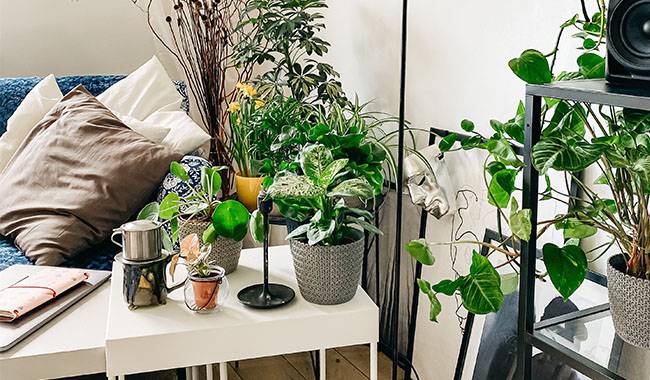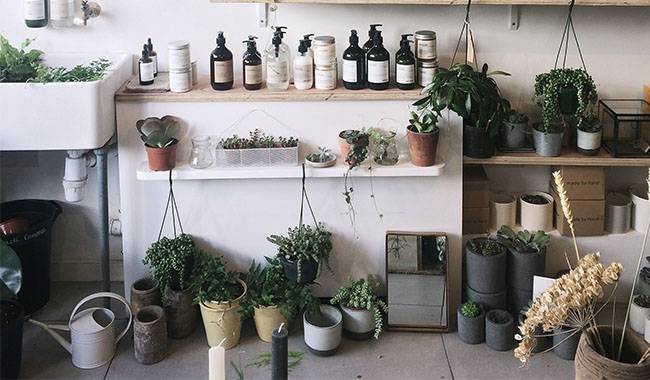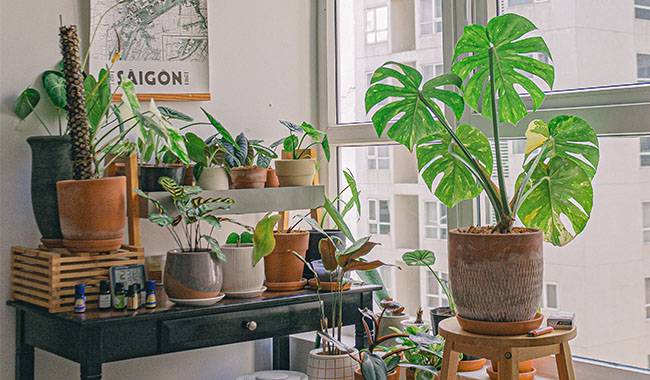
Those who have lived in a wooden house know how easy it is to breathe there. Even “deadwood” creates a comfortable environment for us. And this is certainly true of living plants! Pine forests, birch forests, oak forests, willow bushes, and simply miscellaneous meadows – everywhere you can breathe easily and freely. It seems that even health is improved! (It doesn’t look like it, but it does add up). The main reason for the fresh air in forests and meadows is the plant pesticides and the negatively charged ions released by the plants. This article is about using the properties of plants to make the air in your home healthier. You will learn The Healthiest Houseplants Bring Healing air to our Home in the ThumbGarden article.
WHAT ARE BOTANICAL INSECTICIDES?
People used to use unnamed phytocides (many thousands of years ago): putting mint and fennel in sarcophagi, wrapping food in horseradish or nettle leaves, steaming with birch brooms, putting birch and bird cherry branches with young leaves indoors, and quilting fruit trees with branches of elderberries to keep caterpillars at bay. Although it’s not fair to the tree, a Christmas tree is also a way to use plant hormones to improve indoor air health.
Of course, there are some quirks – some of the more “avant-garde” wear cut garlic cloves as protection against vampires. Vampires must have a problem with garlic because it has acquired such properties.
B.P. Tolkien officially introduced the concept of phytocides into science in 1928: “Phytocides are volatile bioactive substances formed by plants that kill or inhibit the growth and development of bacteria, microfungi, and protozoa.” This is a very enthusiastic man, by the way. His book “Therapeutic poisons of plants” is easy and interesting to read, and in addition, it contains a lot of useful information for gardeners on plant interactions.
According to recent data, in addition to antimicrobial action, phytocides can have insecticidal and anthelmintic properties and general stimulation of the body, anti-inflammatory, regenerative, anti-allergic, interferon production, and other effects.
There are currently difficulties in terminology. In particular, the concept of “phytocide” is very diverse, both at home and abroad: it is not only a volatile substance but a protective substance for all plants. But let the biologists deal with the terminology, things must be practical.
This article is about volatile substances released by plants for their purposes.
WHY USE PLANT PESTICIDES?
The main purpose of plants is to protect their health and integrity, but the targets of their attacks are different. It depends on the level of annoyance and the extent to which pest enthusiasts get rich in the name of others. This is why the composition of the volatile substances released by each plant is different.
For example, the phytohormones of walnuts repel insects – it’s very comfortable to have a summer table under the tree. The insecticides of conifers are so ingenious in dealing with germs and bacteria that the air in pine forests, especially the young ones, is virtually sterile. And those volatile compounds present therein act most beneficially on humans by destroying disease-causing microflora in the respiratory tract and lungs themselves. Juniper produces the largest number of phytocides.
The volatiles of valerian improve the cardiovascular system, the mouth-leaf fern successfully repels insects with its phytohormones, and horseradish excretes large amounts of fungicides. The phytohormones of oak have a blood pressure-lowering effect. Garlic, lemongrass, and eucalyptus release a complex of substances that stimulate the immune system to fight viruses.
Volatile compounds in cherries and bird cherries can kill a mouse (what damage do mice do to them?) However, this is under laboratory conditions, and plant insecticides do not occur in nature in such concentrations, only enough to deal with protozoa, bacteria, and fungi. In general, eucalyptus synthesizes some monster, a biological coagulant.
In general, phytocides are part of the plant’s natural immunity, a volatile plant antibiotic. Microorganisms, and indeed insects, are not dormant but adapted to all these poisons. This is why there is no shortage of pests in nature. Evolution in action: plants invent new defenses, while pathogens invent ways to survive and pest.
If volatile compounds are so useful, it is a good idea to have plants with known beneficial properties in your home.
HEALTHIEST HOUSEPLANTS WITH ESSENTIAL OILS

Each flat and house has its conditions, very different, and the occupants have their ailments in various ways. There are various aspects to choosing plants depending on the tastes and preferences of the owners. Especially for bedrooms, living rooms, and children’s bedrooms, it is recommended to choose plants separately. Some people may also consider it a feng shui problem, that’s for sure.
If you have respiratory problems, Myrtus communis will help. It is a pretty shrub (or tree, as it is formed) with glossy leaves containing essential oils and fluffy, fragrant white flowers. Very plain but needs at least a few hours of direct sunlight. Its odor is somewhat similar to that of conifers. It grows easily from seed. It can be planted in any room.
Eucalyptus is equally beneficial to the respiratory tract. It also belongs to the myrtle family and has essential oils in its leaves, only ‘enhanced.’ Eucalyptus is anti-infectious against respiratory and digestive pathogens, pustular skin diseases and stimulates the immune system. An added benefit is that it repels insects. The volatile compounds of eucalyptus increase vitality and performance. So its place might be in the living room.
There are a number of plants used for an indoor culture that have different shapes and colors of leaves, scents, and habits. For example, the lemon-scented Corymbia citriodora.
Eucalypts are light-loving, drought-tolerant, and cope well with their own and others’ diseases, so they are plain except for their need for direct sunlight. Both Myrtle and Eucalyptus show quite vigorous flowering on windowsills in the south and west. Eucalyptus, like myrtle, grows well from seed.
Geranium, a favorite of many flower growers, also contains essential oils in its leaves that can successfully fight many microorganisms. Also, the scent of geraniums has a relaxing and soothing effect, so they are a good place to put them in the bedroom. Not everyone likes the scent of geraniums (you have to listen to your body’s preferences!) ), but there are different species and varieties so that you can experiment. For me, lemon geraniums proved to be acceptable.
Geraniums are not demanding and can grow even on a northern windowsill, but they will only bloom in large numbers in direct sunlight.
Lemons, citrus, coriander, and citrus fruits in general. They are more capricious than before, but citrus, that is, have access to fruit. They also contain essential oils and release phytohormones, which have a negative effect on many bacteria and protozoa. The scent of lemon leaves can lower blood pressure. The flowers also smell good. By the way, flowers and fruits also tend to produce phytocides.
You can put them in all rooms, considering they like light, high humidity and not too high temperatures. A double-windowed northeast bay window has proven to be the best choice for lemons in my office. And at home, one meter away from the south window.
Citrus copes well with human pathogens, but with the scab, spider mites, somehow they don’t do so well and need help.
Salvia Rosmarinus has a unique flavor and works well against pathogens that cause respiratory and digestive diseases and suppress fungi. It also has great culinary properties. It prefers light and cool temperatures and is otherwise undemanding.
This list could include bay laurel, conifers, jasmine, fragrant laurel, and lavender.
If the plants are newly grown or not yet purchased, you can use essential oils from these plants. During the heating season, it is good to place drops of the oil on a cotton pad and place it on the radiator.
HOUSEPLANTS WITH NO NOTICEABLE ODOR
Not everyone likes the smell of plants that release essential oils – some people may even get a headache. Fortunately, you can find something that doesn’t stink as much and is just as useful.
Everyone is probably familiar with Chlorophytum comosum. It doesn’t release such a pronounced odorous substance into the air like myrtle, eucalyptus, and geranium, but it cleans the air of pathogens all the same. It is common and ordinary. Because of its simplicity, abuse it in any way you can: push it into a dark corner, place and hang it in the kitchen near a hot pan, hang it in the most uncomfortable places – it endures and benefits everywhere. Not only does it fight pathogens, but it also absorbs formaldehyde, heavy metals, and benzene.
Good in all rooms and all species with minimal fuss, broad-leaved, narrow-leaved, mottled, curly, and even orange. The more, the better in numbers – the plants are not too big. Propagation by progeny is easy and simple. It is much harder to kill it than to grow it.
Spurflowers, also known as room mint, is a good bedroom plant. Its volatile compounds are not as vicious as geraniums, but they are insect repellents, and the shrubby Spurflowers successfully repel moths. The faint scent of Dianthus relieves fatigue and relaxes the mind. It also encourages concentration, so it’s great for when you’re at the computer. Even tank battles next to it will be more effective, and remote work will be more productive.
It is an ampeloglossum, not demanding, does not need direct sunlight, and is easily propagated by stem cuttings.
Aloe arborescens also does a wonderful job of disinfecting the air with outrageous patience, and the healing properties of its leaves are legendary. It can be placed anywhere. The only restriction is on the floor of a nursery with small children: the thorns on the leaves can hurt children’s delicate skin. Of course, it will heal immediately, but why shed more tears?
Dieffenbachia is a living room plant. Not only because of its monumental appearance but also because of its milky white sap, which irritates the skin. As long as the plant has not been cut, broken, or had its leaves torn off, it is harmless and has strong healing properties.
It effectively kills microorganisms and cleans the air of dust and harmful substances produced by furniture and paint. Moreover, the large, evaporative leaves make the air in dry rooms easier to manage. This plant is shaded tolerant and grows quickly, and I have not seen any pests. It reproduces easily through the stem nodes.
Begonia × albopicta W. Bull can be placed in any room, not in direct sunlight. Its phytocide has a particularly positive effect on the microorganisms that cause respiratory diseases. It blooms from December to April, maybe longer, in bunches, and looks quite decorative.
Her requirements are acceptable: bright diffused light, warmth, and adequate watering, without standing water. There is no need for spraying. Propagation by stem nodes and leaves is not difficult.
Aglaonema, ivy, sansevière, dracena, spatifillum can be added to the same category.
WHAT OTHER BENEFITS DO HEALTHIEST HOUSEPLANTS OFFER?

Lovers of geraniums are well aware that disturbing foliage smells several times stronger. In general, this is characteristic of all plants – when micro-damage occurs, the release of volatile substances increases. This doesn’t mean you have to torture the plant in any way, but running your hands over the leaves does help. Especially in the bedroom, before going to bed. Young leaves, newly opened flowers, and unripe fruits produce more phytohormones.
In addition to releasing plant pesticides and negatively charged particles into the air, plants in the house effectively raise air humidity, reduce noise levels, and absorb harmful substances that are present in large quantities in the unit. Some plants can balance the negative effects of radiation in the home. We also have aromatherapy and color therapy, in which plants play an important role.
Dear Reader, Of course, it would be problematic to describe all useful houseplants in one article. The fact that all plants have antiseptic properties has already been mentioned. Not all of them have been studied. Experiments have been conducted mainly with plants used in traditional medicine, and there is still a vast field to be explored. For now, we use what is known. And we have a personal healing garden in our own homes.







